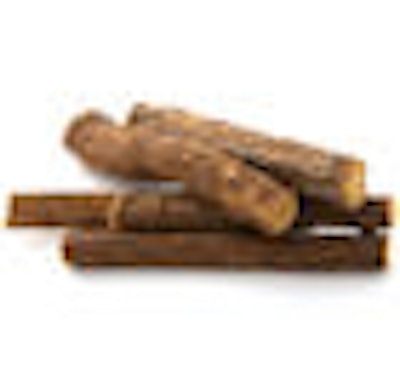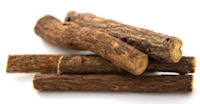
Is the best new approach to preventing caries actually thousands of years old? That's the implication of recent company-sponsored studies on toothpastes that borrow from traditional Indian and Chinese medicine chests.
One study, sponsored by Colgate-Palmolive, featured Colgate Ayurveda Sampoorna toothpaste, which is made with a proprietary herbal formula drawn from ayurveda, the traditional system of medicine used in India.
"A lot of people in India are using it because it's nonchemical," said co-author Kanupriya Kakar, B.D.S., a private dentist in New Delhi.
 |
| Licorice root is one of the most common ingredients in Chinese herbal treatments. |
The other study, conducted by Hawley & Hazel Chemical, featured a toothpaste containing licorice extract, which is frequently used in traditional Chinese medicine.
In both studies, presented at the 2009 International Association for Dental Research (IADR) meeting in Miami -- investigators compared the herbal toothpastes to fluoride toothpastes in randomized controlled trials.
For the Indian study, 57 people brushed with the ayurvedic toothpaste and 55 brushed with the control toothpaste for 12 weeks, with recalls at 6 and 12 weeks.
Using the Quigley-Hein Plaque Index (Turesky modification), the researchers found that the subjects reduced their plaque from 1.98 ± 0.42 at baseline to 1.85 ± 0.4 at six weeks and 1.79 ± 0.38 at 12 weeks using the control toothpaste.
Using the ayurvedic toothpaste, they reduced their plaque from 1.98 ± 0.34 to 1.55 ± 0.29 at six weeks and 1.49 ± 0.29 at 12 weeks.
The reduction in plaque was 15% greater for the ayurvedic toothpaste at 6 weeks and 16% greater at 12 weeks.
The reduction in gingivitis on the Löe-Silness Gingival Index was 20% greater for the ayurvedic toothpaste at 6 weeks and 21% greater at 12 weeks. The differences on both indexes at both intervals were statistically significant (p < 0.0005).
The researchers also measured the difference between the two groups using ayurvedic indexes of dental debris and redness. For dental debris, they found an 11% greater reduction at 6 weeks and a 15% greater reduction at 12 weeks for the ayurvedic toothpaste. For redness, the reduction was 12% greater for the ayurvedic toothpaste at 6 weeks and 15% greater at 12 weeks.
The licorice researchers backed their clinical trial with laboratory data. They obtained an extract from Glycyrrhiza inflata, a plant used to produce licorice. The extract contained more than 20% licochalcone A, a compound previously shown to have antiprotozoal, anti-inflammatory, antitumor-promoting, antioxidative, and antimicrobial properties. They then formulated a toothpaste with a 0.3% concentration of this extract.
In the laboratory experiments, they cultured onto hydroxyapatite disks saliva from a volunteer who had refrained from oral hygiene for 24 hours. Then they treated the disks with a slurry of either the G. inflata or the regular toothpaste, and incubated the disks for 18 hours. After that they measured the optical density of the different disks.
They found that biofilm on the G. inflata disks was 25% less dense than the biofilm on the regular toothpaste disks.
"Our study clearly showed that licochalcone A has a broad spectrum of inhibiting the growth of oral pathogenic bacteria, for example, P. gingivalis, F. nucleatum, A. naeslundii, and S. mutans," they wrote. "That suggests that this toothpaste has the benefits of controlling dental plaque."
For the clinical phase of the study, the researchers compared the two toothpastes in 19 volunteers in a double-blinded, randomized crossover study.
After washout, the subjects brushed with one of the two toothpastes. A baseline plaque score was identified using the published Modified Gingival Margin Plaque Index (MGMPI). The researchers measured the subjects' plaque again 24 hours after they had brushed.
When the subjects brushed with the G. inflata toothpaste, they had a plaque score of 19.86. When they used the regular toothpaste, their score was 23.13. The difference was statistically significant (p < 0.05).
"The data suggest that the use of licorice toothpaste may help control dental plaque and keep a good gum health," the researchers concluded.
Copyright © 2009 DrBicuspid.com



















